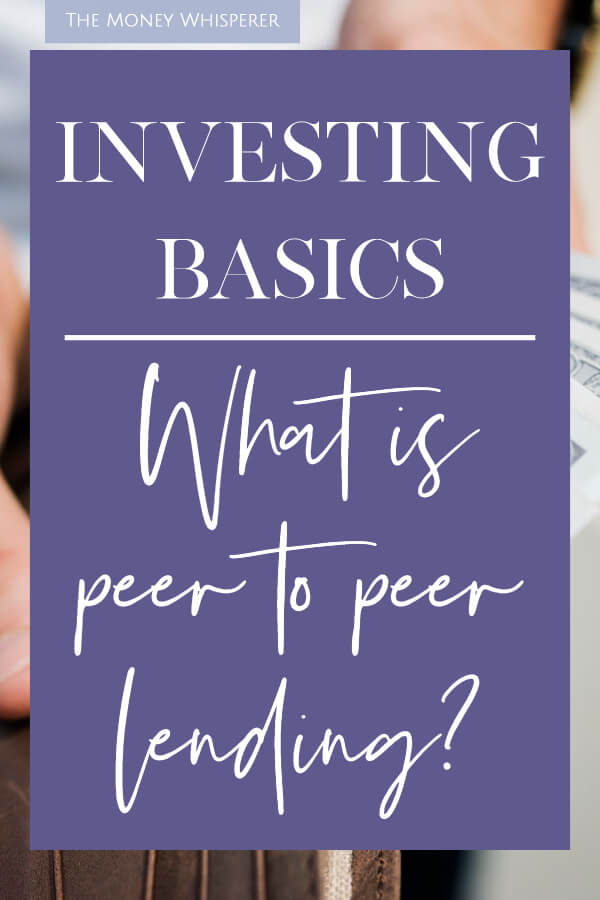This post may contain affiliate links which means that if you click through to a product or service and then buy it, I receive a small commission. There is no additional charge to you.
Disclaimer: Capital at risk. No FSCS protection. Past performance is not an indication of future performance. You may want to consider advice from a qualified financial adviser before investing.
Investing Basics : What is Peer to Peer Lending?
Our ‘Investing Basics’ series has been designed to help those who are interested in investing but don’t know where to begin, or who want to open their eyes to their options. The aim is to discuss topics with minimal jargon so you have more confidence in, and knowledge about, the options available to you on your investing journey.
Following on from my article on how inflation is eating up your savings, I had lots of people contact me to ask what the alternatives to saving money in cash are. People frequently tell me they feel stocks and shares are ‘too high risk’ and that they are looking for something with a lower level of risk, but which still gives them a better rate of return than in the bank.
Today, I have teamed up with RateSetter to talk about peer to peer lending (P2P) and demystify how it all works. RateSetter was founded in 2010 because the founders wanted to address exactly what we identified above – the investment gap between cash and shares, and to make better returns accessible to everyone in a simple and modern way.
So let’s dive in – what is peer to peer lending?

Let’s talk lending for a minute. It’s a pretty simple concept; A needs money, B has that money and is willing to loan it to A on the assumption that it will be returned at a point in the future, with interest paid on top of the original loan amount.
Historically, if you were A, B was a bank.
Lending money is bread and butter for a bank. After all, that’s how banks generate profit, by taking deposits from customers and lending that money to borrowers.
Now, if you are a customer with your deposits at the bank, you want to know that if your money is being lent out by your bank, it is safe. Banks are highly regulated with the objective of keeping your deposits safe, but this comes at a price to you; low returns. As we’ve talked about previously, the interest you receive on your current accounts, and even term deposits and savings accounts is typically lower than the current rate of inflation.
Step in peer to peer lending.
Peer to peer lending provides the opportunity for individuals to act as the lender and lend money directly to other people or businesses – with no bank in sight – for higher returns.
Peer to peer lending fills a gap in the market, with advantages for both lenders and borrowers:
- Lenders can potentially generate higher interest rates than could be earned from holding their money in banks and other financial institutions
- Borrowers have an alternative to the finance which they may get from standard financial intermediaries
How Peer to Peer Lending Works
If you were to lend money in a single loan to one borrower, and they missed a payment, you wouldn’t get your interest payment. That doesn’t sound hugely appealing does it? Too risky!
With P2P, lenders place their money with a peer to peer platform, and their money is then lent to lots of different borrowers – individuals, businesses and property developers – as many small loans. Each borrower borrows small amounts from many different lenders to make up the full loan they need.
Investors then earn interest every month, with returns that are higher than savings and more stable than stocks and shares.
The P2P platform acts as an intermediary to collect the repayments of interest and capital from each borrower and pass them to the lenders.
What Rates of Return Can I Get With P2P?
Rates of return vary across lending platforms as you would expect. They also depend on the length of time you are prepared to lend your money for..
If we use RateSetter as an example (as it is the UK’s most popular peer to peer investment platform based volume of lending), they offer three different markets available for an investor, the main difference being the rate and fee to access.
- Rolling market – 3.4% annualised interest, paid monthly with no fee to access your money
- 1 Year market – 4.3% annualised interest, paid at the end of the term with 0.3% fee to access your money early
- 5 Year market – 5.4% annualised interest, paid monthly with 1.5% fee to access your money early
(rates are the averages for Jun 19)
Your unique attitude to risk and capacity for loss will determine which investment type would best suit you, and this determines your corresponding rate of return.
What To Look For In A P2P Platform
With the potential for increased returns comes greater risk. That is how investing works; investors are rewarded, typically, for taking greater risks with greater financial rewards.
Keeping your money deposited in a low interest bank account allows it the protection of the Financial Services Compensation Scheme. P2P lending isn’t covered by the FSCS, but lending platforms tend to put their own provisions in to protect lenders. So, you want to be sure that you select a lending platform which has:
- A good track record of lending to high quality borrowers
- A provision fund to protect its ability to pay your agreed rate of interest even if a borrower defaults on paying their interest.
Past performance is not a guarantee for the future, but during RateSetter’s nine-year track record, every RateSetter investor has received all the interest and capital that they expected, due to its Provision Fund which protects invests against missed borrower payments.
People who take out a loan pay interest on the money that they have borrowed. At RateSetter, part of the interest goes to the investor, while another part goes directly into the Provision Fund. What this means in plain English is that if someone defaults on their interest payment in any given month, RateSetter can still make your payment to you as the investor from this Provision Fund.
Investing in P2P via an Innovative Finance ISA
P2P lending is available both inside and outside an Individual Savings Account (ISA). The advantage of investing within an ISA is that all gains are tax-free.
RateSetter’s Innovative Finance ISA has now passed the milestone of attracting well over £200m in subscriptions and is believed to be the most popular Innovative Finance ISA in the market.
The RateSetter ISA is positioned between the safety, but low returns, of a Cash ISA and the potentially large returns, but volatility, of a Stocks & Shares ISA. It provides:
- Stability: As with all investments, scale and diversification is important. At RateSetter, investments are matched with individual borrowers, but with the stability of returns are based on the performance of the entire £850 million portfolio.
- Track record. RateSetter has a 100% track record of £3.2 billion invested over 8 years, ensuring that every investor has made a positive return on their money. This is made possible with their Provision Fund.
- Early access: As an investor you would naturally get access to your money in line with borrower repayments. If you need access to your money sooner, you may like to know that on average investors have released their investment within 24 hours.
New investors are currently being offered a £100 bonus when they invest £1000 for 1 year.
Please note that tax treatment depends on individual circumstances and may be subject to change in the future.
This is a collaborative post.

